Monday, December 10, 2007
Interactive floor - now this is wild!
You will need content for the Eyestep Floor to work, animated, live-action and programmed 2-D and 3-D. This is where 3-D Revolution Productions can help. Do not hesitate to contact us!
Monday, December 3, 2007
Glib Reduction
---
Article:
"The presentation of films in 3D is as old as the movie business itself, but clumsy technology and unrealistic effects have so far kept it out of the mainstream."
Reply:
The 3-D boom of 1953-54, when over 100 Hollywood 3-D feature titles were released, did so using twin-camera filming and polarized projection - the only difference with today's technology being that it was done on 35MM film, rather than on HD video. You have clearly never seen a twin-projected film from 1953, as most of them blow today's 3-D releases right out of the water in terms of a 3-D cinematic experience. The claim of "unrealistic effects" is based on nothing, as exactly the same 3-D compositions, shots and camera moves are employed today as they were then.
Article:
"The technology to achieve and watch 3D has come a long way since cinema-goers wearing red and green glasses leapt from their seats during Jaws 3D. That was in 1983, when a film created for traditional projection was then rendered into 3D in post-production."
Reply:
Sorry, but this is completely based on fantasy and, I strongly suspect, misinformation supplied by modern day 3-D camera system providers. Jaws 3-D was shot with a 3-D camera adapter called StereoVision, on 35MM film. This was then projected using, as in 1953, polarizing projection lenses, but this time using special StereoVision projector adapters. The beauty of that system is that it all worked with existing technology and standards of the time - unlike today's need for digital switch-over before 3-D can be presented. No red-blue anaglyphs were ever used to project this movie other than maybe for poor cinemas in the Asian subcontinent and lagging-behind (or poorly supplied) Europe!

StereoVision 3-D adapter for 35MM film cameras
Article:
"The high resolution of the twin digital images can now be maintained not only in post-production but through to distribution and exhibition, as digital cinema systems replace 35mm print reels and projectors."
Reply:
I have to remind you about 70MM film 3-D presentations that were done in the 1970s - no newer format other than IMAX has ever gotten close to that image quality. And although digital projection is obviously more stable than 35MM projection, the eyes cannot distinguish between 35MM film projection of 3-D and digital projection of 3-D.
Article:
""There are very few technical challenges left for deploying 3D," declares Joshua Greer, president of RealD, which holds a monopoly on 3D presentation systems."
Reply:
There are at least 3 competing big name digital 3-D projection systems on the market, being Real-D, Dolby 3-D and NuVision, although I can understand that Joshua Greer would like to see that point differently. It is true, though, that Real-D does have the most aggressive marketing strategy and has managed to convince more theatres than any other 3-D projection brand to incorporate their technology in the new digital projection rooms.

Real D Projection adapter
Article:
"Four releases to date have suggested that 3D could drive studio profits in the next decade. Disney's Chicken Little, Meet the Robinsons and The Nightmare Before Christmas 3D and Sony's Monster House all earned three times as much revenue per screen as the 2D version of the same film on their first weekend of release."
Reply:
The real fact is that the cinemas showing these movies charged more for the cinema tickets, explaining the higher profits. So although 3-D can mean higher revenue in the short term, it is not a sustainable and realistic business model in the long term, as consumers will not continue to pay higher prices for their cinema tickets. Will you? Especially if 3-D becomes something of a standard?
Article:
"It also currently costs an extra US$10m-15m to make a 3D movie"
Reply:
Compared to what exactly and for what kind of a movie? Animation will quickly cost 130-150% in 3-D, while live-action will easily cost 150-175% of a regular movie. Talk to any stereographer and 3-D consultant like myself and you will hear the same numbers.
Article:
""None of the 3D systems in the past allowed you to immerse yourself in the frame," Walden Media CEO Cary Granat tells Reuters."
Reply:
I am sorry, but that is just pure nonsense. Go and see 1953's 'House of Wax' or 'Dial M for Murder', followed by 'Chicken Little' or 'Meet the Robinsons' and have another look at that statement. Immersing yourself in the frame with 3-D is everything to do with the 3-D camera work, not the technology. And they did that a hell of a lot better in the 50s and 80s than they are doing right now.
---
If you are a journalist or an editor and you would like to learn more about 3-D Film, from a more accurate perspective, I will be more than happy to write you a piece on the subject. Large and well-respected magazines like Animation Magazine have already published some of my writing on 3-D focusing on 3-D stereoscopic animation production and the technical and creative implications of 3-D filming and animating.
Alexander Lentjes
3-D Revolution Productions
Tuesday, November 13, 2007
A meeting of 3-D minds - HD vs. 35mm vs. twin-camera vs. anamorphics for 3-D

Anamorphic Side-by-Side 3-D on Film - a bit like Cinemascope for 3-D
Very recently I had an e-mail conversation with 3-D Revolution’s Gary Palmer on 3-D, HD, the best 3-D filming solution currently available and the Pace Fusion 3-D camera issues. The conversation touched upon many core issues of current 3-D film production and, I feel, reflects what many stereographers today think and feel but are not saying out loud. Or maybe we just share a very different viewpoint of 3-D Stereoscopic Film Production from the stereographic profession. Either way, I though it would be a nice read and possibly even useful to publish this conversation in the 3-D Film & Animation Production Blog…
And so here it is. Alexander Lentjes
You can find Gary’s marvellous work on the 3-D Film List at 3-D Revolution Productions here:
www.the3drevolution.com/3dlist.html

Twin-HD machine camera 3-D setup
Gary Palmer starts with two questions:
First, what do you think would be the ideal 3-D shooting format? In all the years I've been studying this subject, my own 'favourite' has to be the 65mm single-strip system devised by Jan Jacobsen in the 1960's, in which left-right 35mm frames are placed side by side in the space normally occupied by a single 65mm frame, and subject to an anamorphic squeeze, resulting in a 2.21:1 aspect ratio. This allows for *full* 35mm resolution. Transferred to Digital 3-D format at 4K resolution (reconfigured to 2.39:1 AR), this would surely provide the best and brightest 3-D format of them all, above and beyond anything so far offered by HD origination…

The late Jan Jacobsen working on one of his camera systems
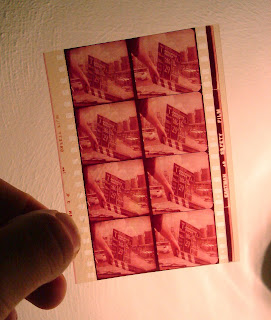
65MM Side-by-side film strip - photo courtesy of Roloff deJeu
Second, going back to those comments you made earlier concerning the poorly composed images from the Fusion 3-D rig. Surely in today's world of digital post-production, the kind of badly-converged imagery you mentioned would be noticed by someone in the editing suite? How on earth can such material make its way to the screen in today's digital environment? After all, if *you* noticed problems, surely it must have been evident to others? It'll be interesting to see how both SCAR and JOURNEY 3-D measure up when they're finally released to theatres in the New Year...

Steve Hines with his superior 65mm Hines Rig
Alexander Lentjes answers:
Hmm, an interesting question about the ideal 3-D shooting format. I would have to vote for the twin-65mm Hines Rig that Disney commissioned for the MAGIC JOURNEYS and CAPTAIN EO shoots and has used on all their subsequent 3-D productions. Yes, there is loss of light, but there is a same amount of loss in a lens adapter like the side-by-side one you describe. The disadvantage of a S-B-S adapter is the need for anamorphics, which will often introduce geometric distortions and thus parallax issues. It's much more compact, though, and if you compare one 65mm camera with a twin-65mm camera rig, it's clear which setup is the most practical of the two. So it's a choice of handle-ability vs. pure quality. If you have the lights and the hydraulic camera cranes and cable systems, go for the twin-camera solution!
Of course, in that light, one must mention the twin HDV camera solution as that finally means a portable twin-camera rig (shoulder mount or steadicam), but then again HDV uses a low resolution compare to true HD and 35mm so for theatrical release it may be not that interesting.
 Twin-HDV 3-D Rig solution for hand-held shooting
Twin-HDV 3-D Rig solution for hand-held shootingA side-by-side twin-camera solution like Fusion 3-D is always going to introduce a big interaxial and for that reason alone it should be approached with due care. Why do you think there has been so much work going into getting those darn lenses closer together over the years? Surely not to then just ditch a century of cinema research and simply shoot with a 70-75mm interaxial!

A very large interaxial for a giant-POV type shot, dwarfing the imagery shot
Also, they shouldn't be touching that convergence button as much as they do. Sure, it's a tool in 3-D, but one that must be used with utmost limitation and due care - not per default and without any consideration for its consequences. Like HD is a step back in comparison to 35mm and especially 70mm, 3-D appears to be devolving with the current Stereo Camera trends...
3-D professionals should be able to see that the Pace imagery is uncomfortable to watch and dwarfs all subject matter. But it appears that somehow vertical parallax is suddenly acceptable on a professional level - and my biggest fear is that these professionals are just shooting themselves in the foot because Joe Bloke the Consumer is going to be very discomforted and angry when he sees that material in cinemas and on his brand new 3-D TV. The industry should acknowledge that 3-D filming is just not the same as 2-D filming - but they're selling (and buying) it that way right now!
Gary responds:
The reason I asked the question is because I share your aversion to the idea of HD replacing 35mm (or 65mm) film, and was wondering what might be used instead of HD. The various single-strip 35mm solutions are fine for what they are, but they involve cutting the 35mm frame in half, with all the attendant loss of resolution. I absolutely *despair* that Super 35 has become the widescreen format of choice these days (it isn't 'widescreen' at all, it's 'cropscreen') for that very reason.
The dual-65mm rig would certainly provide excellent images and would allow for high-grade digital prints (as long as 4K was used, of course). However, given the size of the cameras and the rigs needed to control them, it doesn't seem practical in modern filmmaking terms, especially if you need to cover a particular scene with two or three cameras at once.
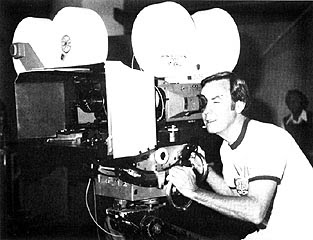
True 65mm Twin-camera setup: bulky and heavy...
The post-production issues surrounding any future productions shot in single-strip 65mm should not be an insurmountable problem for any DP who takes such issues on board and is careful during principal photography… I think dual-65mm is too impractical for modern filmmaking practices and won't be considered anytime soon, whereas the development of lightweight cameras for single-strip 65mm amounts to a more reasonable expectation.
James Cameron and co. want HD to become the international standard. Not surprising, given that Cameron and most of his contemporaries have been trying to blur the boundaries between film and TV since around 1990. When was the last time you saw a film on a Big Screen which didn't look like a dress rehearsal for the DVD release? Note the preponderance of close-ups and medium shots, the 'TV-friendly' two-shots, etc.
It's still early days in the 3-D renaissance. And it's interesting that you and I both chose a 65mm solution, quite independently of one another. Who's to say 65mm *won't* be considered by Hollywood in due course, by filmmakers who care about the images they're creating (not an unreasonable assumption - parts of the new BATMAN film are being shot in Imax format, for example)? Who's to say lightweight cameras capable of single-strip/anamorphic (or even spherical) 65mm won't be developed as the 3-D revolution gathers pace, even as types like Cameron and Rodriguez continue to insist HD is the 'future of film'?

Spy Kids 3-D: shot on HD and almost fully against Greenscreen
Again, it's still early days, and no one is going to accept those flaws for very long. I say, wait until SCAR and JOURNEY 3-D arrive in cinemas next year. After all, it may not be the Fusion cameras at fault, but those who are using them!
So far, Joe Public has seen very little of the digital 3-D revolution except animated films. It's the *live-action* stuff that's going to decide the future of 3-D acquisition, and we haven't seen nearly enough of it to make a final judgement.

Chicken Little: remember that 3-D Animated CGI title?
We're on the brink of something marvellous. Along with colour, sound and widescreen, 3-D completes the illusion of film as a window on the world (and any other world filmmakers care to imagine!). We have the means to get it right this time, and I refuse to believe *everyone* who works in the format is going to stand for the 'second-best' option proffered by Cameron and his associates...

Aliens of the Deep: underwater 3-D by James Cameron & Vincent Pace
Thursday, November 8, 2007
3-D Stereoscopic Post Production

An optical Printer - nowadays replaced by D.I. and digital magic
3-D Stereoscopic Post Production. The words strike fear into most Post facilities’ hearts. It is not surprising, as there are two major factors that determine a 3-D pipeline;
First and foremost you will need to truly understand 3-D to be able to do Post for it. Luckily, knowledge can be brought in by means of getting a 3-D consultant (aka a stereographer) involved in the (Post) Production process.

Twin HD shooting - two HD
streams to deal with
The hands-on side of 3-D postproduction is more demanding – and a lot more expensive. Editing is already a big leap from plain old flat 2-D to 3-D, with its requirements of slower cuts, convergence and interaxial matching from shot to shot and overall z-depth eye-guiding within the frame. But doing effects, colour correction, grading, geometric distortion correction, and playing it all back in 3-D is a very different game altogether. Of course, there is the issue of needing to be able to process and play back two streams of 2K or 4K D.I. or HD material, preferably without hiccups – as frame drops introduce out of sync 3-D, which is not only unwatchable, it is purpose defeating to the whole process of 3-D stereoscopic Posting.

The Quantel Pablo with 3-D Stereoscopic Editing capabilities
This is where very recent arrivals on the stereoscopic playing field come into play. Quantel suggests a 3-D solution that works with their ‘Pablo’, ‘iQ’ and ‘Max’ system. With the ability to play back 2 streams of 2k (1920p) material (or 1 stream of 4k material), it fits the bill for quick, rough 3-D editing and 3-D conforming. A few tools are introduced that allow for getting the two video streams in sync, both time- and colour/exposure-wise, while allowing for touch-up painting to get rid of nasty 3-D inequality like reflections, lens flares, scratches and other retinal rivalry-inducing artefacts. Besides offering rudimentary image distortion correction. The beauty is that it is all real-time and render-free. The choice of 3-D output is left up to the user, with two independent SDI / DVI streams coming out of the Pablo. So that can be anything from a field/frame sequential solution like CrystalEyes, plain old Anaglyph previewing or full-blown twin-projector polarized projection.

The Quantel Pablo 3-D interdace with Ghost of the Abyss under the 3-D knife
A very similar solution has been released by Assimilate within the ‘Scratch’ solution. This product boasts 2x 4k stream processing with all the horns and bells of the Quantel box, but with a similar price tag and running on Boxx PC hardware, not custom Quantel stuff. That price tag lies round about 70k in Pounds Sterling, but that is a price that would be incurred with a D.I.Y. approach with Boxx-like PC or Octo-Core PowerMac hardware as well, while frame stability is guaranteed in Scratch and Pablo, versus not-so-certain perfect playback in the D.I.Y. solutions.

Assimilate Scratch 3-D Stereoscopic Post Solution
It is certainly good to know there are working tools available to correct simple 3-D camera problems, but it is imminently preferable to shoot it all properly and trouble free in the first place. Quantel’s showreel contained a lot of Pace material, shot by Vincent Pace and James Cameron with the ‘Reality Camera System’, now renamed to ‘Fusion 3-D’. Pretty much every shot in that reel uses converging cameras, large interaxials, wide-angle lenses and fast camera moves. These clips are labelled (and considered) state-of-the art 3-D HD material, but by nature they are headache-inducing, poorly executed 3-D shots. Not exactly the ambassadors of 3-D film and television one would ideally want.

The Pace Fusion 3-D Camera
We’re not being negative about big names in 3-D image acquisition for the sake of it here, we’re trying to say that it’s time to look past the glib and to start really, closely looking at 3-D material to realize what is good 3-D and what is just not acceptable as a professional standard. Unless you are happy to correct every frame in post or leaving your audience with a big hangover from watching your 3-D film and television show, that is. If you are going to shoot in 3-D, you will have to use its own particular language, its unique pace, its different compositions. Respect the medium or discomfort your audience – just like with colour and sound, where too loud, all the time, is just not an experience people will walk away from with pleasant memories and smiles on their faces.
Monday, October 15, 2007
Top Twenty list of the Best 3-D Effects in Film
Wanting more
OK, there are quite a few more great objects that have come at ya in 3-D film history, so here’s number 11-20 of the list. Or you could call it a second top 10 list, whatever sounds better.The Top Twenty List - numbers 11-20
Of items coming out of the screen in 3-D films
As composed by Alexander Lentjes of 3-D Revolution Productions
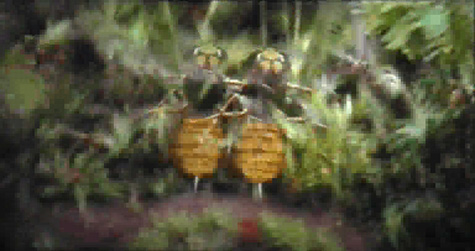
Dancin' like a butterfly, stingin' like a wasp
Apologies for this image not being in 3-D; it is almost impossible to get 3-D plates of 4-D attractions. If you know of a 3-D version, do let us know!![]()
12. Borg medical probe - Star Trek: The Experience – Borg Invasion 4-D (2004)
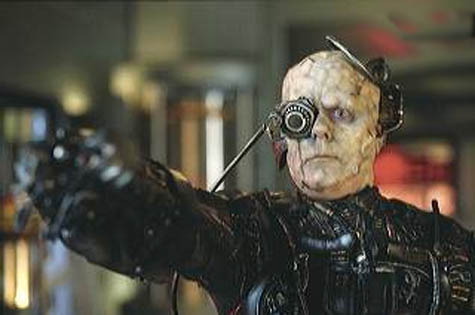
Resistance to the 3-D effects is futile
Apologies for this image not being in 3-D; it is almost impossible to get 3-D plates of 4-D attractions. If you know of a 3-D version, do let us know!![]()
13. Rebecca Morbidus - The Incredible Invasion of the 20,000 Giant Robots from Outer Space (2000)
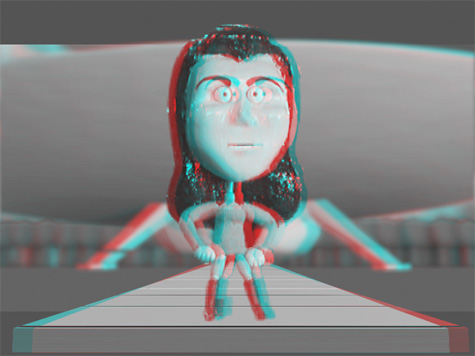
I come in pieces
14. Metal T-1000 claws - Terminator 2: 3D (1996)
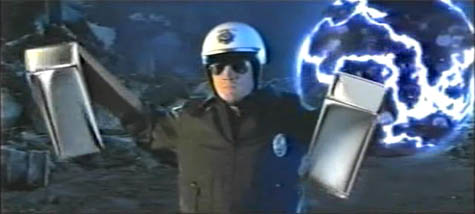
The future is not a happy, fluffy place
Apologies for this image not being in 3-D; it is almost impossible to get 3-D plates of 4-D attractions. If you know of a 3-D version, do let us know!![]()
15. Severed arm - Jaws 3-D (1983)
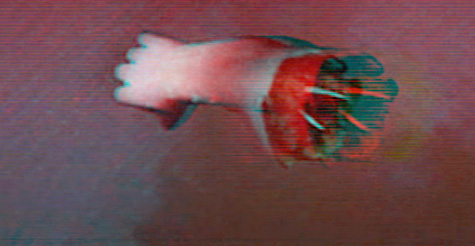
3 Dimensional fish bait
16. Bath bubbles - The French Line (1954)
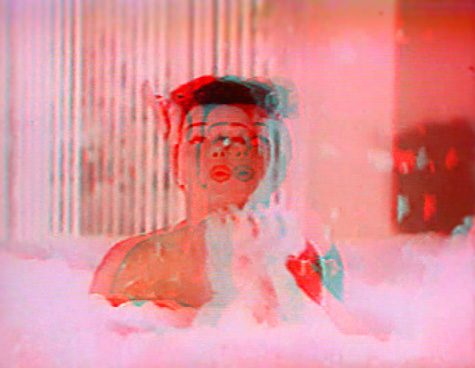
After building that Chrysler engine in 3-D, J.R needed to scrub herself clean
Because it’s so incredibly rare to see a quality lead in 3-D, let alone a singing and dancing one with endless legs! The French Line and it’s focus on a 3-Dimensional J.R. is a great stereoscopic musical treat. This particular shot with the bubbles is an imaginative one, which ties in with the story and doesn’t overdo it. A very nice balance is struck, and that, too, is rare in 3-D.
17. Floating hunter robots - Terminator 2: 3D (1996)
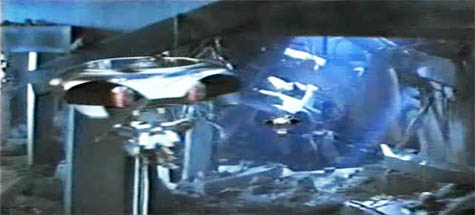
Hunter Killer robots: it's the future
Before Avatar and even before Aliens of the Deep, James Cameron did Terminator 2: 3-D. The floating robots come out of the screen as they are searching for the Terminator and John Connor. These floating robots are in CGI, while the action behind it is all pure live-action film. They do make sense in the story and the 3-D is not out of place in this movie because it is preluded and followed by real actors on stage. I needn’t mention that the terminator also sticks his shotgun out of the screen multiple times throughout this Universal Studios 3-D theme park movie.
Apologies for this image not being in 3-D; it is almost impossible to get 3-D plates of 4-D attractions. If you know of a 3-D version, do let us know!![]()
18. Jared-Syn’s arm - Metalstorm (1983)
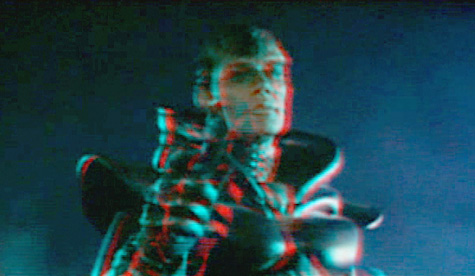
Reach out and touch someone
The biggest beauty of this shot, though, is Jared-Syn’s costume, which is very round and volumetric. Probably the best costume design for 3-D film ever employed. This film was made for 3-D release and almost all shots are set up for impressive 3-D. Too bad the story is rubbish and the acting forgettable...
19. Hungry Giant’s head - Barbie and the Magic of Pegasus (2005)
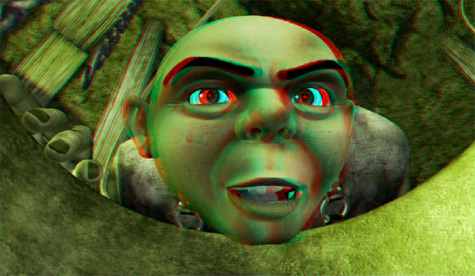
Lunchtime - and one dream of Bratz is very close to getting fulfilled
20. Spraying canister - Medium – Still Life (2005)
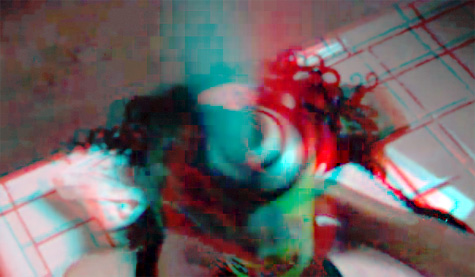
Fish head!
At 3-D Revolution Productions we can seriously help you to create compelling, thrilling and well thought out 3-D shots. Just contact us for more information on how we can assist you with your 3-D Film, TV or Web Production.